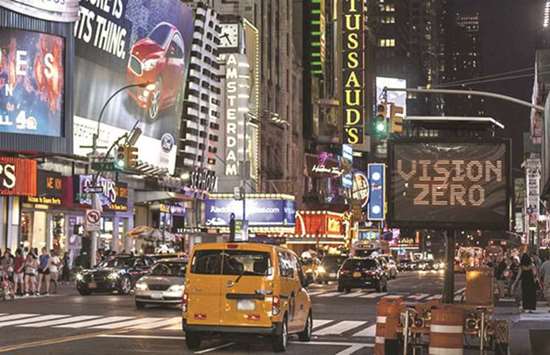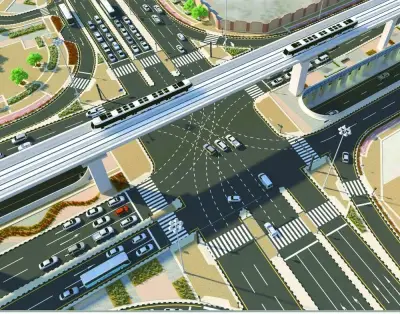Bill de Blasio was two weeks into his term as New York mayor when he stood with weeping parents at the street corner where eight-year-old Noshat Nahian was killed while walking to school and pledged to end the city’s “epidemic” of road deaths.
Noshat was crossing the seven-lane Northern Boulevard in Queens with his 11-year-old sister five days before Christmas 2013 when Mauricio Osorio-Palominos, operating an enormous truck on a suspended driving licence, turned left across their path. Noshat was the 11th child under 13 to be killed on the streets of New York that year.
The urgent 30-day plan De Blasio ordered became the first Vision Zero policy of a major US city, blazing a trail for mayors around the world to tackle what the World Health Organisation calls a “major but neglected global health problem” and which killed 1.25mn people in 2013. In two weeks in late November that year, four New Yorkers were killed by drivers on sidewalks, sparking protests.
Vision Zero, a road traffic safety project pioneered by Sweden in 1997, has since been adopted by the likes of Paris, Berlin, Stockholm and state of Victoria in Australia. At its best, it focuses on evidence-based interventions around anything from safer vehicles to safer roads, covering engineering, education and enforcement. However, as any city can call itself or its safety programmes Vision Zero, the results are mixed.
US states that adopted Vision Zero saw fatality rates decline 25% faster than the national average from 1997 to 2014. But reducing road deaths in the long-term means redesigning roads to restrict motor traffic – and that’s where things get difficult.
New York aimed to halve traffic fatalities by 2025 by bringing together City Hall, the police department and the Department of Transportation. Although it was the safest city in the US in terms of road deaths and serious injuries, it was on a par with cities in eastern Europe and Latin America.
De Blasio announced that speed cameras near schools would start issuing tickets for the first time the day after he stood on that street corner, and police would begin prioritising road crashes. He convinced the state government to lower city traffic speeds, a key factor in road deaths, and targeted the High Injury Network. These “boulevards of death” – state highways doubling as neighbourhood streets, like Northern Boulevard and Queens Boulevard – make up 15% of the road network but account for 60% of pedestrian fatalities.
As Kate Fillin-Yeh, strategy director at the National Association of City Transportation Officials, puts it: “Designing 60mph streets didn’t work in a city context, but people didn’t know what better was. The thing we should be thinking about is how many people can we move, not how many cars.”
New York’s Vision Zero programme targeted 50 such roads and junctions. Slow zones, speed cameras, street lighting and traffic signals were introduced in areas where data showed they were needed most. The city set up community outreach and worked with taxi organisations.
By 2017 road deaths had fallen 28% from 2013 levels, and pedestrian deaths 45%, to the lowest point since records began.
Fillin-Yeh says: “If you have a programme focusing on the things that save lives, designing streets to protect people biking and walking, you will have a successful vision zero.” Focusing on education alone, she says, “won’t achieve anything”.
While New York has some of the lowest traffic death rates in the country, Los Angeles has the highest, with a person killed in traffic every 40 hours.
In January last year the city’s mayor, Eric Garcetti, announced its first Vision Zero strategy, with a goal of eliminating traffic deaths by 2025. Work would focus on 40 High Injury Network streets, particularly those near schools. Interventions included pedestrian scrambles, painted kerb extensions protected by bollards, and left turn safety improvements .
However, things started to unravel. On Temple Street, where 34 people were killed or severely injured within 2.3 miles in eight years, a “road diet” expected to reduce crashes by up to 47% met backlash from residents and drivers. Local city leaders downgraded lane removals to things that wouldn’t interfere with motor traffic: sidewalk repairs, new traffic signals and crosswalks.
Road deaths rose rather than falling, increasing 80% in two years. Then state legislators chose to increase speed limits on LA’s High Injury Network roads.
Jon Orcutt, who was director of policy at the NYC Department of Transportation from 2007 to 2014 and developed De Blasio’s Vision Zero programme, says: “Los Angeles had no safety policy before Vision Zero, it’s pretty common across the US. There’s nothing to build on and you have established this really ambitious goal and it’s hard for everyone to figure out what’s going on.”
He says local council leaders who did back Vision Zero in LA were left isolated and “hung out to dry” in the face of opposition.
Orcutt also expresses his frustration at a lack of ongoing improvement in New York after those initial improvements.
“We need leaders to say, ‘This is what we are doing in the city, and you don’t get to say no, and you don’t get to come back on what our technical experts say,’” he says. “That is the power of the mayor – that’s the point of the megaphone you have.”
Policing is too often a major stumbling block for Vision Zero improvements – not least in New York, where 66% of fatal crashes were caused by unsafe speed, driver inattention or distraction, failure to yield, traffic control disregard or drunk driving – in other words, risk-taking behaviour by drivers.
Despite overall fatality reductions, between 2013 and 2017 New York hit-and-run collisions resulting in injury increased 14% to more than 5,000. NYPD make an arrest in just 9% of hit-and-run injury cases and less than half of the fatal cases. Meanwhile, NYPD ticketing of cyclists increased 25% from 2016 to 2017: 23,452 summonses were issued to cyclists in 2017 alone. In July, state legislators turned off speed cameras in New York, only to reinstate them in autumn after more than 300,000 drivers were logged speeding near schools in two-and-a-half weeks.
While the New York police are performing fewer crash investigations, in LA police used “pedestrian sting” operations to catch jaywalkers at busy Metro stations. Streetsblog LA called them “one part of a system that criminalises the poor, especially youth of colour.”
Montgomery County in Maryland also has a Vision Zero policy, but perhaps no one told Tom Didone, captain of the traffic division, who called pedestrians “lazy” for not using crosswalks after seven people were killed by vehicles in less than three months.
This summer London became the latest global city to announce a Vision Zero programme, focusing on speed reduction, bus and lorry safety and cycling and walking infrastructure, as well as tackling the city’s most dangerous junctions. Bringing together policing, transport and city hall, the target is to eliminate all 2,000 annual road deaths and serious injuries in the city by 2041, with interim targets to reduce them by 65% by 2022.
As in LA, London’s plans for safer streets have been dogged by local opposition.
In June, mayor Sadiq Khan’s flagship pedestrian safety scheme, the pedestrianisation of Oxford Street, was blocked by the local borough, Westminster city council, following local concerns about traffic displacement.
This was despite Oxford Street’s poor safety record – with two pedestrians killed and 15 seriously injured between 2014 and 2017.
Lloyd Alter, design editor of TreeHugger.com and architect, sees the physical road changes as crucial in reducing deaths.
“I love the idea of Vision Zero and wish it was implemented,” he says. “The problem is, it becomes a cliche rather than an actual plan.
“The fundamental issue in America is that almost anywhere they try to implement Vision Zero, almost everyone in those cities drives. They aren’t willing to be slowed down, they object, and the politicians refuse to do anything that’s going to make drivers angry.”
He references Toronto, where the aim was a 20% reduction in the number of pedestrians killed and seriously injured over 10 years. Academics dubbed it a “poor and tragically designed version” of Vision Zero.
“Everybody picks and chooses what they want, and in the end it isn’t Vision Zero at all,” Alter says. He believes Vision Zero needs stronger wording similar to the Stop de Kindermoord movement in 1970s Dutch cities.
“We should rename it ‘Stop Murdering Our Kids’: make it real and make it something much stronger, because it’s just lost its meaning,” he says. “When it came over from Sweden it was a plan, it was things that we did, now it’s just a cliche.”
Even Sweden has stumbled on the road to zero road deaths, though, and readjusted its target to no more than 220 deaths a year by 2020.
Ultimately, says Alter, zero road deaths may not be achievable, “but it is worth having as a goal.” - Guardian News and Media

Vision Zero, a road traffic safety project pioneered by Sweden in 1997, has been adopted by several cities around the world.


